AMD Ryzen 5 3600 Review: Why Is This Amazon's Best Selling CPU?
by Dr. Ian Cutress on May 18, 2020 9:00 AM ESTTurbo, Power, and Latency
Turbo
As part of our usual test suite, we run a set of code designed to measure the time taken for the processor to ramp up in frequency. Recently both AMD and Intel are promoting features new to their processors about how quickly they can go from an active idle state into a turbo state – where previously we were talking about significant fractions of a second, we are now down to milliseconds or individual frames. Managing how quickly the processor fires up to a turbo frequency is also down to the silicon design, with sufficient frequency domains needing to be initialized up without causing any localised voltage or power issues. Part of this is also down to the OEM implantation of how the system responds to requests for high performance.
Our Ryzen 5 3600 jumped up from a 2.2 GHz high-performance idle all the way to 4.2 GHz in 16 milliseconds, which coincides exactly with a single frame on a 60 Hz display. This is right about where machines need to be in order to remain effective for a good user experience, assuming the rest of the system is up to scratch.
Power
With the Ryzen 5 3600, AMD lists the official TDP of the processor as 65 W. AMD also runs a feature called Package Power Tracking, or PPT, which allows the processor to turbo where possible to a new power value – for 65 W processors that new value is 88 W. This takes into account the power delivery capabilities of the motherboard, as well as the thermal environment. The processor can then manage exactly what frequency to give to the system in 25 MHz increments.
As part of my new test suite, we have a CPU power wrapper across several benchmarks to see the power response for a variety of different workloads.
For an AVX workload, y-Cruncher is somewhat periodic in its power use due to the way the calculation runs, but we see an almost constant 90 W peak power consumption through the whole test. The all-core turbo frequency here was in the 3875-3925 MHz range.
Our 3DPMavx test implements the highest version of AVX it can, for a series of six 10 second on, 10 second off tests, which then repeats. In this case we don’t see the processor going above 75 W in the whole process.
Photoscan is our more ‘regular’ test here, comprising of four stages each changing between single thread, multithread, and variable thread. We see peaks here up to 80 W, but the big variable threaded scenario bounces more around the 60 W mark for over 1000 seconds.
On the per-core power side, using our ray tracing power load, we see a small range of peak power values
When one thread is active, it sits at 12.8 W, but as we ramp up the cores, we get to 11.2 W per core. The non-core part of the processor, such as the IO chip, the DRAM channels and the PCIe lanes, even at idle still consume around 12-18 W in the system.
Latency
Our latency test is a simple core-to-core ping test, to detect any irregularities in the core design.
The results here are as expected.
- 7.5 nanoseconds for threads within a core
- 34 nanoseconds for cores within a CCX
- 87-91 nanoseconds between cores in different CCXes


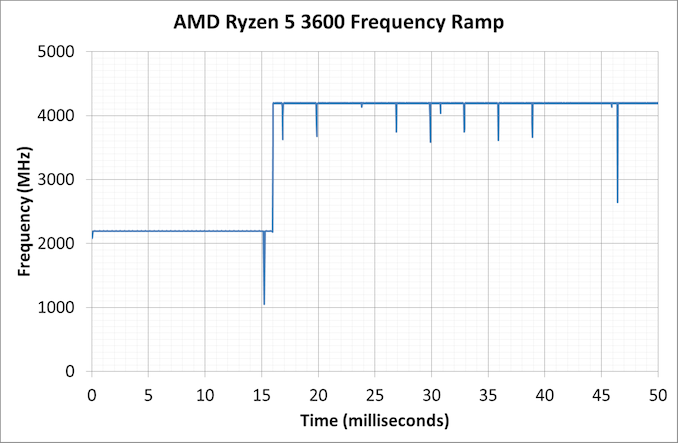
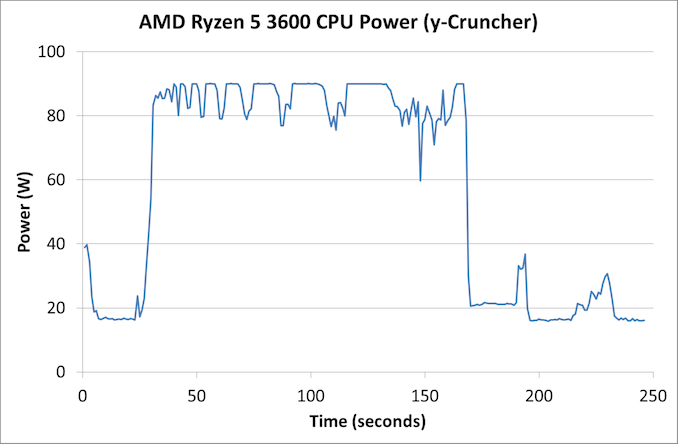
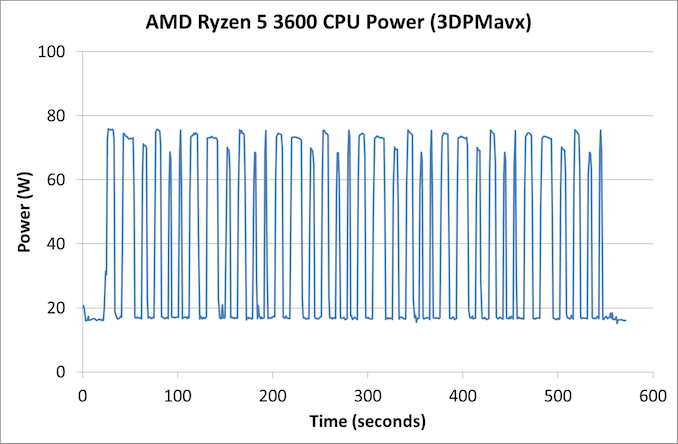
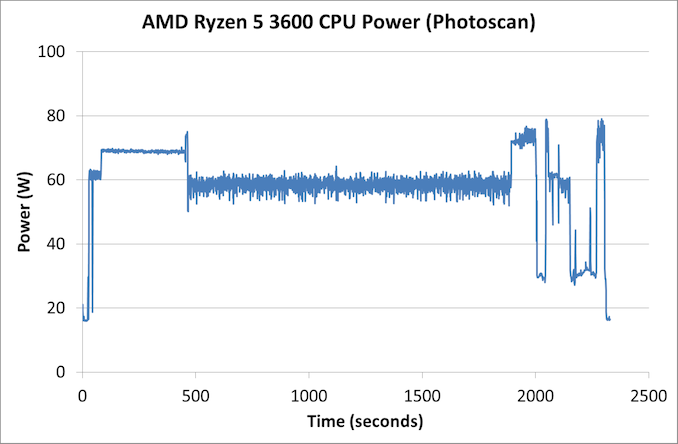
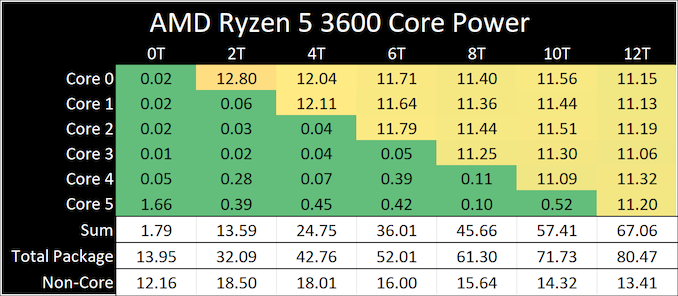
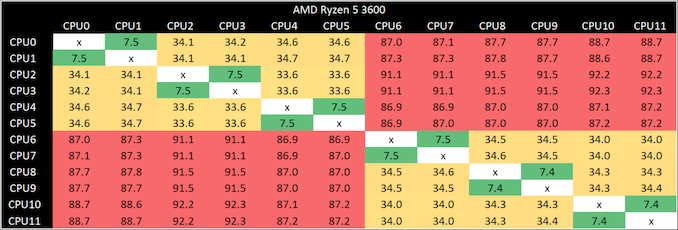








114 Comments
View All Comments
eastcoast_pete - Monday, May 18, 2020 - link
Thanks Ian!While this is not important for many (most?) readers here, I would like to see AMD or anyone else putting a more basic GPU (under $ 50 retail) out that has HDMI 2.0a or better, display port out, and that has ASICs for x264/265 and VP9 decoding; AV1 would be a plus. This could be a PCIe dGPU or something directly soldered into a MB. Am I the only one who's find that interesting? I don't like to always have to plug a high-powered dGPU into each build that has more than just an entry level CPU, so this would help.
Spunjji - Tuesday, May 19, 2020 - link
You'll likely be waiting a while. You'd need to wait for the next generation of GPUs with new display controllers and video decoders. There's a rumour that Nvidia will be producing an Ampere "MX550" for mobile, which could mean a dGPU based on the same chip being released for ~$100. Give that a couple more years to drop in price and, well, by then you'll probably want new standards. :DPgndu - Monday, May 18, 2020 - link
I come here for a clearer perspective more than benchmarks, but the timing of this article is weird, especially since 10th Gen's at the door. I get the market or Atleast pc builder cause and effect but market just got blown out of proportions with options, what actually transfers to general populace is not clear until OEM's embrace the reality like nividiaArbie - Monday, May 18, 2020 - link
"The Core i5-10500 ... is 65 W, the same as AMD".Anandtech knows very well that Intel TDP is not the same as AMD TDP. Please stop falling into the noob-journo trap of simply repeating the Intel BS just because it's official BS.
GreenReaper - Monday, May 18, 2020 - link
In fairness, TMD is also turboing to 88W, with cores plus uncore measured as taking significantly more than 65W.Spunjji - Tuesday, May 19, 2020 - link
Absolutely right, but also in fairness, Intel's sole enhancement for the 10 series appears to be enabling higher clock speeds - and they're made on the same process with the same architecture as the 9 series, which inevitably means more power will be required to reach those higher clocks.So, it's likely to be either a CPU with similar real power use to the AMD processor that never really hits its rated turbo clocks, or a CPU that does hit its rated turbo and never drops below ~100W under sustained load. It's likely to be power and speed competitive on an either/or basis, but not both at the same time.
watzupken - Tuesday, May 19, 2020 - link
This is true that its going above its TDP to provide the boost speed. However this is a practice that Intel has practiced since its Kaby Lake/ Coffee Lake series. Unfortunately, they are the worst violator when it comes to exceeding the supposed TDP when you consider how much power it is pulling to sustain its boost (PL2) speed. If you consider the boost speed of the Comet Lake, even the supposed 65W i5 10xxx series is not going to keep to 65W given the boost speed of up to 4.8Ghz, though nothing is mentioned about the all core turbo, but should be somewhere close, i.e. 4.2 to 4.6Ghz is my guess.lakedude - Monday, May 18, 2020 - link
I assume no one has mentioned the typo since it is still there."Competition
With six cores and twelve threads, the comparative Intel options vary between something like the Core i7-9600KF with six cores and no hyperthreading..."
Gotta be i5, right?
Kalelovil - Tuesday, May 19, 2020 - link
@Ian CutressThere appears to be a mistake in the AI Benchmark results, the Ryzen 5 3600 Combined result is less than the sum of its Inference and Training results.
xSneak - Tuesday, May 19, 2020 - link
Disappointed to see the continual cpu reviews using a GTX 1080 as the gpu. We would be better able to evaluate cpu performance if a 2080 ti was used given it is cpu bottlenecked at 1080p on some games. Hard to believe one of the biggest tech sites is using such under powered hardware.